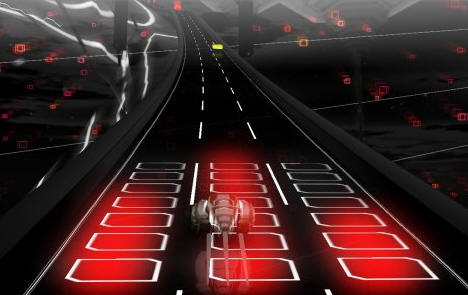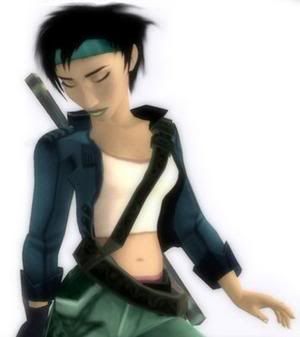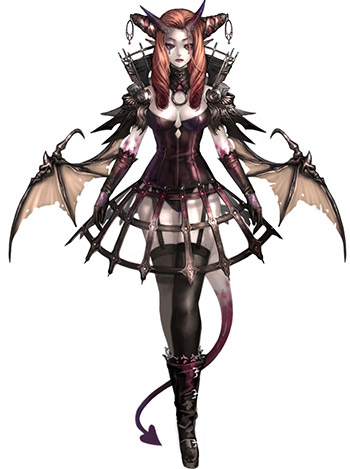IT'S AUDIOSURF VS BEAT HAZARD!
Gameplay
As we all know, gameplay is a crucial aspect in making your game a success. And both games manage to deliver well with it. Beat Hazard has a shooter aspect to it that allows you to control a tiny ship that shoots other ships and asteroids to boost up your score whilst jamming to your tunes. While you do this, you have to collect power ups such as volume (which increases the volume which helps you fire more), power (which makes your guns more powerful, as you'd imagine), super-bombs (which creates an explosion that takes the whole screen up in it's radius) and +1, +5, +10 orbs (which increase your multiplier which helps to make your score all the more larger). You also can collect $10 triangles that can help you obtain perks which can reward you with more power-ups as well as unlock more difficult modes.
You always start out with 4 lives and you got to make the most of them, because you don't get any more. That, and you die in one hit. Once you max your volume and your power, you enter into Beat Hazard mode where everything gets more frantic than usual. You can either play through one track of your choice or go for as many tracks as you can with Survival Mode. There's also the possibility that in your tune, you may encounter boss ships which will use everything they can to eradicate you. So be wary of that.
Audiosurf plays it's game with a different mechanic. Yes, you have a little ship just like in Beat Hazard, but instead of shooting everything in site, you're going on a roller-coaster like track created by your song and trying to collect colored squares into a grid. Get three of the same color touching each other and you gain points. Seems simple, no? You can go with a whole array of ships which have their own special abilities that can change up the way you go about the game. Like there's the Mono ship that allows you to jump from the track and only has two types of blocks (colorful and grey), one you collect (colorful) and one you avoid at all costs (grey). And the Pointman ship that allows you to store blocks of your choice so that you can plop them back into the grid when you see fit.
Winner: Tough call, but I'm going to have to say Audiosurf. While Beat Hazard's gameplay is addicting, Audiosurf's gameplay is addicting and original. It's a unique puzzle mechanic that not only provides you to act fast, but also think fast. Beat Hazard's simply just based on half of that.
Graphics/Extra Bits
Now, you all know what I mean by graphics, but since there's another bit to games that isn't graphics but is closely related to it because it helps with the presentation of the game, I've decided to make this graphics and extra bits. Audiosurf's graphics are very polished and have a good sense of color to them. It's a bit epileptic at times, but you're entranced by the mere visuals of the track changing color from time to time. It's very well done. The menus also have a good variation of color and selecting your ship for the game is pretty neat, especially when you look at the designs for the logos of the ships.
Beat Hazard's menu may not be anything spectacular visual-wise, but whenever you open the game up, you have the opportunity to listen to some of your songs as a menu music theme. In a way, it's nothing much, but in another way, it sometimes seems like the song that is playing should be a menu theme. It gives off a sort of delightful yet bizarre feeling when you realize that. The ships look very shiny looking and the color that radiates from destroying the enemy or firing your projectile is magnificent if your eyes are able to handle such intensities.
Winner: While Audiosurf's colorful visuals are beautifully appealing, Beat Hazard takes the cake with having that color be splashed on like an artist waving his brush madly into a painting, spewing the paint all over the place. Unless you have problems with quick flashing lights, the vision of seeing so many different colors burst out as you're shooting down ships is captivating and really engages you in a psychological way. Plus, having that extra part of your own music being the menu theme really shows that your music is what affects the game.
Music Integration
Now some could consider a nitpick here, but I believe that this aspect does affect how spectacular a music-revolved game is. If a game can properly integrate the mood, the feel, and the volume of the music of your choice in the level that you're about to play, then it's doing it's job right. Audiosurf's way of doing this is by waiting for a while to create a track for you to go about. Depending on the tempo, the rhythm and the intensity of the song will determine how many twists, ups and downs, turns the tack will have. Beat Hazard on the other hand lets the music control how powerful your projectiles are, how fast the enemy ships go and how many of the enemies ships you get in a period of time. Both truly allow you to know what song to choose when you want something less chaotic or when you really want to test your metal.
Winner: Again, it's a real tough call here, but I'm going to have to say Audiosurf. With Audiosurf, you're at least certain on what parts dictate the way the track is formed. With Beat Hazard, while there are elements present there that prove how the music is integrated in the game, sometimes they're inconsistent. Primarily with how many ships come out at one in a period of time and what causes a boss ship to be triggered. It's never fully structured, so it just feels like they just throw anything there, no matter if it syncs with the track or not. Audiosurf also takes it's time to properly integrate the music into the level, so that sort of helps but them ahead with the tiny details.
Challenge
If you're one of those people that wants to get the most out of a video game, you want as much challenge as possible. Both games deliver with difficulty levels ranging from piss easy to incredibly hard as well as tons of achievements that you can do your best to obtain.
Winner: Well, Beat Hazard has 5 different difficulty levels, but when you get to harder modes, they just turn out to make the sort of cheap difficulty that isn't due to you not being better at the game but due to there being no way you can avoid the enemy. The survival mode also falls prey to this at times. It's somewhat balanced by the perks and the super-bombs, but not to the fullest extent. Audiosurf does balance things out so that the challenge feels that it is surmountable, if only you dedicate more time to the game itself. Even the most difficult parts such as trying to get no greys at all with Ninja Mono seem like they can be overcome if you just tried more and more. And for that, Audiosurf wins here.
WINNER: AUDIOSURF
While I enjoy playing a good amount of Beat Hazard, Audiosurf clearly shows to the be the more balanced and the more creative game out of the two. It properly integrates the music, provides a decent amount of challenge and it makes you think fast as well as react fast. Plus, it was complete once it was released unlike Beat Hazard which got a "DLC"-like version called Beat Hazard Ultra with more features and gadgets to mess with.
Well that's all I've got to share here. G'bye!









